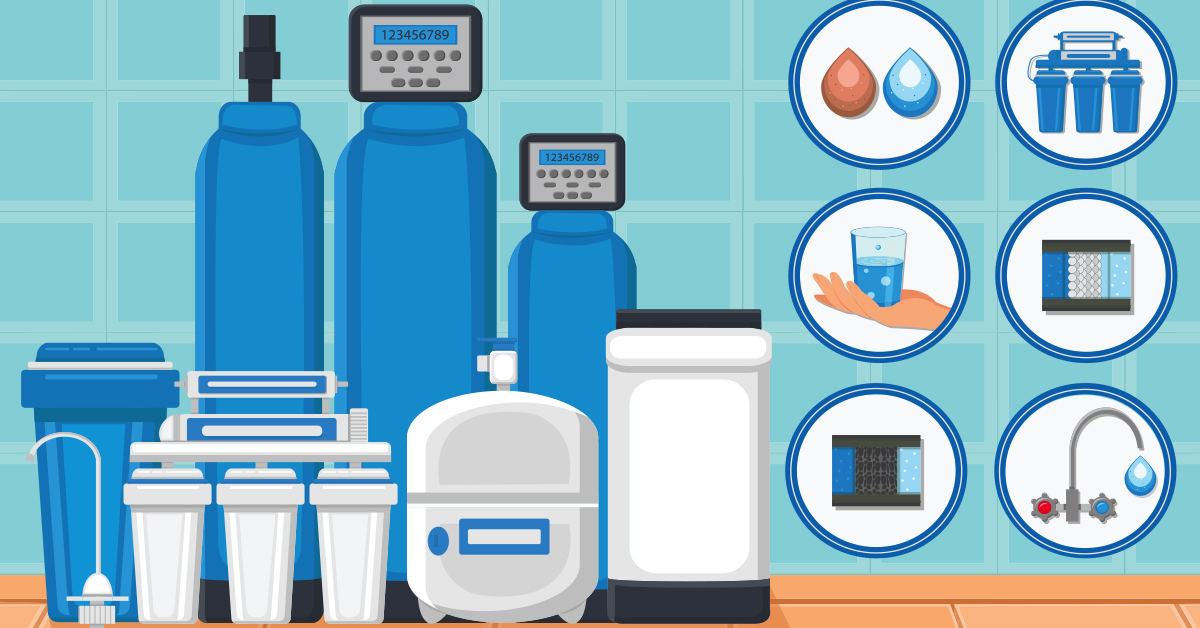Household Water Filters vs. Reverse Osmosis
The biggest difference between Reverse Osmosis (RO) and common household water filters is the number of contaminants it removes.
Posted in

Your home might rely on one of three commonly used household water filters. Which include refrigerator filters, pitcher filters and faucet filters. Or, your family could be using another treatment method like reverse osmosis (RO).
But not all household water filters reduce the same amount of contaminants.* Refrigerator filters reduce only three and pitchers reduce four. Meanwhile, faucet filters reduce 11 contaminants commonly found in tap water.
However, a Culligan reverse osmosis system with Total Defense Filter reduces 26 of the most common water contaminants.

So, why does a Culligan reverse osmosis system with Total Defense Filter outperform the other household water filters? Because of its advanced filtration process.
Reverse Osmosis
What exactly is Reverse Osmosis?
The reverse osmosis process includes four steps.
First, water passes through a sediment filter. This filter removes sediment in the water, like sand and salt.
Second, the water moves through a carbon filter. Which eliminates any odors or unpleasant taste.
Third, the water pushes itself through a semipermeable membrane to remove any remaining impurities.
And fourth, the water undergoes a final activated-carbon filtration to improve taste and quality for household use. Meanwhile, the removed contaminants are flushed away.
What contaminants does reverse osmosis reduce?
Lead
Most noteworthy, reverse osmosis reduces the presence of lead in water. Which is especially important, because no amount of lead exposure is safe.
Children are especially susceptible to dangerous side effects ranging from stomach pain to brain damage.
Lead is not detectable by smell or taste. So the only way to know if it is in your home's water is to have it tested.
However, a reverse osmosis system in your home is a sure way to significantly reduce lead in your water. And replacing lead pipes, fixtures and faucet screens can also help minimize exposure.
Mercury
Too much mercury in the body causes damage to the kidneys, brain or even a developing fetus. Mercury seeps into water when the earth's crust naturally degasses. And this is increased with human activity like the burning of fossil fuels.
Mercury circulates for months in the global atmosphere. Eventually making its way into lakes, rivers and streams.
Chromium-6
Hexavalent chromium is another name for chromium-6. And this industrial chemical is found in the drinking water of all 50 states. Chromium-6 is a known carcinogen, linked to cancer, reproductive issues, asthma attacks and other severe effects.
Turbidity
Turbidity describes cloudy or hazy water. And it involves the build-up of incredibly small particles. Because the particles are so small, turbidity is usually caused by high sediment levels which enter water supplies through stormwater runoff.
In addition to unpleasant water, turbidity increases the likelihood individuals develop gastrointestinal diseases.
Chlorine
Chlorine is an oxidizing, bleaching and disinfecting agent. Which has been used to disinfect water since the 1890s. High levels of chlorine leave an unpleasant, bleach-like taste in your water. Plus, it dries out skin and hair.
Cysts
Giardia and cryptosporidium cysts cause severe gastrointestinal illness, including cramps, vomiting and diarrhea.
Volatile Organic Compounds (VOCs)
Oil, gasoline, paints and cleaners all contribute to VOCs in groundwater. Because VOCs seep into the ground, they usually end up in nearby wells. Hence, contaminating drinking water. Depending on the level of exposure, volatile organic compounds can cause respiratory illnesses or in severe cases, nervous system damage.
Over 90 Other Contaminants
Culligan's reverse osmosis drinking water system is certified to reduce every EPA-regulated contaminant. Which is more than 100 in total. So in comparison to other household water filters, its treatment power is unmatched.
Out of the 27 most common water problems and contaminants, a Culligan reverse osmosis system with Total Defense Filter removes 26. Such as chlorine, chloramines, bad taste/odor, barium, cadmium, calcium, copper, cryptosporidium, fluoride, giardia, hexavalent chromium, iron, lead, magnesium, mercury, MTBE (gas), nitrate, nitrite, arsenic, radium 226/228, sediment, sodium, TDS (Total Dissolved Solids), TTHM (trihalomethanes), trivalent chromium, turbidity and VOCs (Volatile Organic Compounds).
Water Pitchers
One of the most popular household water filters is the pitcher. Because they have many benefits like easy storage and minimal investment. But how many contaminants do they actually remove?
Unfortunately, not much.
Water pitchers are kept in the refrigerator. So when you get a drink, the water feels refreshing, cold and clean. However refreshing as it seems, there may be lingering contaminants you can't smell, taste or see.
On average, 27 contaminants and water problems plague tap water. And water pitchers only reduce four. Including chlorine, bad taste/odor, cadmium and copper.
Refrigerator Filters
Although the water coming from your fridge filter may appear clean, chances are contaminants remain. Many contaminants, like TDS (total dissolved solids), are difficult to see, smell or taste. And that makes them almost impossible to detect.
Even with regular cleaning and maintenance, impurities can get into a fridge filter at any time. Mold, E.coli and certain kinds of yeast can form on foods inside of your refrigerator. Therefore contaminating the water dispenser.
Of the 27 most common contaminants and problems in tap water, refrigerator filters typically remove two. Such as chlorine and bad taste/odor.
Faucet Filters
While faucet filters reduce strange odors and strong, unpleasant tastes in water, they're likely not reducing as many contaminants as reverse osmosis.
Because faucet filters typically reduce only 11 of the 27 common contaminants and problems found in tap water.
Conclusion
Common household water filters may be convenient. And the water may taste better than untreated water from the tap. But your home deserves better-tasting, cleaner water. Like water that comes from using a Culligan reverse osmosis system with Total Defense Filter.
So call your local Culligan water expert to get started today.
